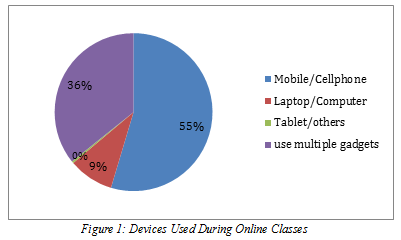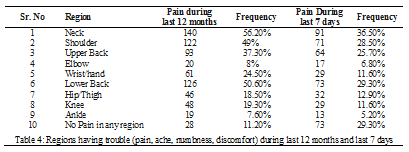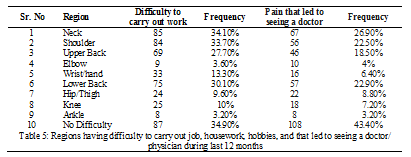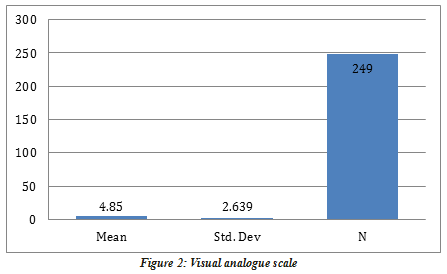Mahnoor Shafi[i], Dr.Saba Riaz[ii], Dr.Somia Sabeeh[iii], Rohma Kiran[iv], Sidra Jamshed[v], Nabia Shahzaad [vi]
DOI: 10.36283/pjr.zu.11.2/010
ABSTRACT
Background and Aims: Due to COVID-19 pandemic, the mode of education changed to online with the help of laptops and mobiles. The aim of this was to find out the prevalence of musculoskeletal (MSK) pain and its severity in students during online learning and the effect of that pain on activities of daily living (ADLs). To find out which regions of the body were more prone to musculoskeletal overload and to spread awareness of ergonomic approaches in device usage.
Methodology: 249 Health Sciences students participated in the study. Informed consent was taken. The prevalence of MSK pain was found out with the help of the Nordic musculoskeletal questionnaire (NMQ) and the Visual analogue scale (VAS).
Result: In our study out of 249 health sciences students, 227 (91.2%) were suffering from musculoskeletal pain. The most affected areas were the neck, lower back, and shoulder. 87(34.9%) had no difficulty carrying out ADLs due to MSK pain. Mean VAS was 4.85±2.63. Neck area 140 (56.2%) was the most commonly affected, followed by lower back 126 (50.6%).
Conclusion: There was a high prevalence of musculoskeletal pain during online education, but a few students experienced difficulty in carrying out ADLs due to MSK pain.
Keywords: Musculoskeletal disorders, COVID-19, postural stress, ergonomics, backache, neck pain, muscular pain.
Introduction
The tale COVID infection 2019 (COVID-19), started in Wuhan city of China, quickly spread throughout the planet, subsequently, individuals were encouraged to be in detachment or lockdown. The World Health Organization (WHO) expressed the COVID pestilence as a pandemic. The COVID-19 outbreak has developed into an international public health emergency1. Considering rising stress over the present COVID-19 pandemic the colleges and universities were avoiding potential risks and steps to forestall2, 3.
Musculoskeletal pain is an acute or chronic unpleasant sensation that affects muscles, bones, tendons, ligaments, and sometimes nerves. As this pain prolongs it can affect activities of daily living up to leading to disability. Musculoskeletal pain can grow into chronic pain syndromes that can be difficult to manage. Patient education, preventative strategies can help in the prevention of chronic MSK disorder4.A switch around in a training framework to online education, with no ideal opportunity for due thought, thus understudy Musculoskeletal (MSK) framework has been affected seriously5.
As we realized that because of the progress of training framework from nearby to online instruction; prolonged, continuous sitting adversely impacts the markers of fringe vascular wellbeing. Examinations have given an account of the focal hemodynamic reaction to delayed sitting, and of these, fringe blood pressures were the essential result6.
According to previous study students who used cell phones and tablets for their online classes suffered from text neck conditions as they flexed their necks in the wrong position and it resulted in undue stress on the cervical. Subsequently, torment in the neck, upper back, shoulder, and upper appendages just as deadness and shivering in hands and fingers7.
A study was conducted in 2021 in India on online education and its relationship with MSD (Musculoskeletal disorders). Musculoskeletal disorders symptoms were registered by 58 % of respondents in the right shoulder region, 56 % in the right-hand fingers, and more than 40% of students experienced musculoskeletal symptoms in almost all of the body parts that were studied, because of virtual learning5.
The research was conducted in 2020 in Turkey about corona phobia, sleeps quality and musculoskeletal pain in staying home and continued working people during the 3-month lockdown. The study revealed that low back pain was higher in the stayed-home group than in the continued working group. Also quality of sleep was quite similar in both of the groups whereas SH individuals had a high rate of corona phobia than CW individuals within those 3-months8.
A research was conducted in 2020 in Naples, Italy. Low back pain was referred by almost 41.2 percent of staff working from home while neck pain was referred by 23.5 percent of those surveyed9. Another research was conducted in 2020 in Mumbai, India to see the effects of lockdown on posture in Physiotherapy students. The most common poor posture patterns were low back pain, neck pain followed by upper back pain, and shoulder pain10.
Another study was conducted in 2020 in India on the effects of ergonomics on those children who learned online during the COVID pandemic Lockdown. Almost 21% of participants suffered from upper back pain, 18% from low back pain and 13% had eye strain11. A study was conducted in 2021 in South Africa to see the prevalence and patterns of MSK pain among students of the university from the physiotherapy and occupational therapy department. After a year, MSP was found to be present in 89.7% of students. The MSP pattern showed that neck pain was the most common (66.2%), followed by LBP (64.4 percent)12.
A study was conducted in India in 2020 about COVID-19 and various applications of SMT (smartphone technology) in the current global pandemic. They concluded that repetitive stress injuries to the musculoskeletal system can be avoided if mobile phones are used properly by health care providers for medical purposes7.
The research was conducted regarding the work-related musculoskeletal disorders in a factory of hazelnut including female workers which showed that many female workers were diagnosed with WMSD (work-related musculoskeletal disorders). It was common in the neck, lower back, shoulder, and upper back13. The research was conducted to analyze Disorders of Musculoskeletal, and Posture sustained during work among Dental and Oral Health Students. The results of this study provided valuable insight into the quite high prevalence of bad posture in dental students of later years14.
A study was conducted to study the challenges, benefits, and strategies during and after the Covid-19 in higher education by online classes. The results revealed that the students found encountered online education as beneficial essentially for promoting online research and getting a good and authentic resource of information and knowledge, although they found reliable internet at the workplace as the hardest and extreme challenges15.Another study reported 85% of students had at least one body part affected. The most frequently identified regions were neck and lower back pain16.By using a tablet, students’ have a perception of having a positive effect on musculoskeletal pain17.Among High-Performance Marine Craft (HPMC) occupants, the most vulnerable parts to work-related musculoskeletal pain (MSP) were the spine and shoulders18.
Risks of neck pain and poor general health were increased when participants did not take breaks and sat all-time at work. (19) Online education had been stressful by affecting the health and social life of students. (20) Among bank staff, the prevalence of work-related musculoskeletal disorders was common.(21) The ergonomic intervention can reduce both musculoskeletal complaints and fatigue22.The prevalence of musculoskeletal disorders in healthcare professionals is high, patient handling tasks being one of the main causes23.
This study found out the prevalence of MSK pain in different body regions and severity of pain in students using different gadgets for online learning. It can help in primary as well as in secondary prevention of MSK pain leading to many serious MSK disorders leading to permanent disability.
Objectives of the Study
The objective of this study was to find out the prevalence of musculoskeletal pain and its severity in students during online learning and the effect of pain on other activities of daily living. It also ruled out which regions of the body were more prone to musculoskeletal overload. Another objective was to increase the awareness of ergonomic approaches in device usage. The student who had pain in our study were guided with ergonomic and postural guidelines. It also spread the awareness of proper posture while using different gadgets used during online education.
Methodology
Statement of Study
Musculoskeletal pain among students due to online learning in COVID Pandemic.
Significance Of Study
The study helps us know the prevalence of musculoskeletal problems in students due to online education (laptop and mobile usage) and to which extend this pain affects activities of daily living. This will increase awareness of ergonomic and correct posture.
Rationale
This study helps us know the prevalence of MSK problems in young students because of the prolonged use of mobile /laptops for online education. MSK pain can lead to serious and irreversible musculoskeletal problems. This study can help as primary and as well as secondary prevention for decreasing MSK burden on students and help create awareness for other populations too.
Study Design
The study design was a cross-sectional study.
Sampling Method
Non-probability convenient sampling technique was used.
Sample Size
The Sample Size was 249 Health Sciences Students calculated by the formula. (24)
X = Zα/22 p (1-p)
Sample Source and Duration of Study
After informing them about our research project and taking their consent, the students filled the form given by us. Data was collected from allied health sciences students of the University of Management and technology (UMT) and the University of Lahore (UOL). Doctor of physiotherapy (DPT) and Doctor of nutrition sciences (DNS) students took part. Data was collected in the first week of April 2021. The study duration was from April 20 2021 to May 30, 2021. Participants were selected according to inclusion and exclusion criteria25.
Inclusion Criteria
- Health sciences students of Age 18-27 years
- Both genders were involved
- Students that took online classes during the period of lockdown brought about by the COVID-19 pandemic in Lahore Pakistan26
- Appeared in Exam after Lockdown started and scored more than 50% (>2CGPA) in it.
Exclusion Criteria
- Those having a history of trauma or injury
- History of musculoskeletal deformities
- Those having any joint disease diagnosed previously24
- Who refused to participate in the study26
Ethical Concerns
Approval from the research ethics committee and Office of research innovation and commercialization (ORIC) department of the University of Management and technology was taken before the collection of data. Ethical considerations were considered during the study. Ethical letter. Respect and human dignity were kept. Informed consent from participants was taken. Confidentiality of their information was protected.
Material
Pen, pencil, paper, and questionnaire form.
Questionnaire
Nordic Musculoskeletal Questionnaire (NMQ) and Visual Analogue scale (VAS)
The Nordic Musculoskeletal questionnaire is designed to provide information regarding musculoskeletal pain in different regions of the body. Score 1 or 0 represents Yes or No for pain.
The reliability of the NMQ, using a test-retest methodology, found the number of different answers ranged from 0 to 23%. NMQ is quoted as a reliable screening tool for MSK pain. Sensitivity 66 and 92% and specificity between 71 and 88%11, 27.
Visual Analogue Scale is a pain scale having 11 points. (0-10) o represents no pain 10 represents worst pain. Test-retest reliability has been shown to be good, but higher among literate (r= 0.94, P= 0.001) than illiterate patients (r = 0.71, P= 0.001) before and after attending a rheumatology outpatient clinic.
Procedure for Data Collection
249 allied health sciences students participated in the study from UMT and UOL. 199 females and 50 males’ students participated. Informed consent was taken before participation. They were selected by convenience sampling. Students have explained the purpose of the study. The confidentiality of the data was maintained in this research.
Data Analysis
The data for research was analyzed by SPSS version 21 in form of pie charts, histograms, frequencies, percentages, means, and standard deviation.
Operation Definition
Body Mass Index (BMI)
< 18.5 underweight
18.5 to 24.9 normal or Healthy
25.0 to 29.9 overweight
>30.0 or higher obese
Pain Severity
0 on pain scale represents no pain
1-3 represents mild pain
4-7 represents moderate pain
8-10 represents severe pain
Results

The minimum age of health sciences students who participated in the study was 19 and the maximum was 30. 5.6% of students had taken online classes for more than 6 months and 94.4% of students had taken online classes for more than 6 months. 199 students (79.92%) students participated in the study were females and 50 (20.08%) were males. 29(11.6%) health sciences students who participated in the study were underweight, 179(71.9%) had normal weight, 38(15.3%) were overweight and 3(1.2%) were obese.

Figure 1 show that percentage of mobile, laptop, tablet and other gadgets use for online learning. Mobile/cell phone users were more in number.

The visual analogue scale has 11 points. 0 shows no pain and 10 shows worst pain. We divided it into 4 categories no Pain (0), Mild Pain (1-3), Moderate pain (4-7), and severe pain (8-10). Students having moderate musculoskeletal pain (4-7 on VAS) were reported more in number.

Table 3 shows that mobile users were in majority and out of 136 health sciences students 19(14%) had no musculoskeletal pain, 32(23.5%) had mild pain, 61(44.9%) had moderate pain and 24 (17.5%) had severe pain.

140 students (56.2%) neck pain was more prevalent in health sciences students in last 12 months. For past 7 days, 91 students (36.5%) neck area was the more commonly affected area, lower back was second most affected, and 73(29.3%) students had no pain/discomfort in any region.

Table 5 shows that 85(34.1%) health sciences students had difficulty carrying out a job, housework, hobbies during the last 12 months due to neck pain; 84(33.7%) due to shoulder; 75(30.1%) due to lower back and 87(34.9%) had no difficulty to carry out a job, housework, hobbies.

Students suffering from neck pain 67(26.9%) that led to seeing a doctor/physician during the last 12 months, followed by shoulder 56(22.5%) and lower back 57(22.9%).
Discussion
The present study reported that out of 249 participants, 22(8.8%) students had no musculoskeletal pain, whereas 227 (91.2%) were suffering from Musculoskeletal pain due to online education during the COVID-19 pandemic. According to a previous study, Musculoskeletal disorders (MSD) were related to online learning due to the COVID pandemic. About 80% of students have experienced issues and various symptoms in their head, neck, or eyes since the beginning of online learning. MSD symptoms were registered by respondents in their right shoulder and right-hand fingers. Furthermore, due to online learning, more than 40% of students reported musculoskeletal symptoms in almost all the body parts5.
The results of our study revealed that 140 (56.2%) health sciences students had difficulty (pain, ache, numbness, discomfort) with their neck, 122 (49%) with their shoulder, 93 (37.3%) with their upper back, 20 (8%) with their elbow, 61 (24.5%) with their wrist/hand, 126 (50.6%) with their lower back, 46 (18.5%) with their hip/thigh, 48 (19.3%) with their knee, 19(7.6%) with their ankle and 28 (11.2%) had no pain in any region during the last 12 months due to shifting of education to online mode.
Whereas according to the findings of a study conducted in India to see the effects of lockdown on posture among students of the physiotherapy department, most participants had inefficient posture patterns and poor postural behaviors. Low back pain (LBP) was the most common improper postural pattern, then neck pain, upper back pain, and shoulder region pain. These were most noticeable in participants who adopted uncomfortable postures because of their poor postural patterns. Half of the participants complained of having a continuous sitting position for almost 4-8 hours every day, with the majority adopting an uncomfortable posture. The causes of their postural problems were bad postural habits as reported by a majority of participants10.
Another research was conducted on children to see the impact of ergonomics due to online studies during COVID-19. The study addressed the effects of poor work posture, repetition, loading, and the most likely causes of pain. Many of them had developed serious problems in just two months, which may raise the likelihood of many debilitating syndromes in the future. Most children worked on laptops, followed by android or apple phones, desktops, and then tablets. Many children were not able to reach their foot on the floor while working causing them to slouch and work with forwarding head posture. According to the study, the ergonomics of children using smartphones was the worst11.Previous studies also showed that online education also increased musculoskeletal and psychological problems in teachers as well. (28) Previous studies also reported neck pain is most common msk problem in computer using students29. Now students have returned to physical classes but there are still many factors that are leading to musculoskeletal discomfort in school students including their heavy school bags and other school necessities30.Rising prevalence of MSK problems in young need to be addressed and taken care of to prevent serious musculoskeletal problems.
This study found out the prevalence of MSK pain in different body regions and severity of pain in students using different gadgets for online learning. Good posture and proper assessment is important to decrease musculoskeletal burden on society. Tele rehabilitation can be helpful in areas where face to face rehabilitation and counselling can’t be done. It can help in primary as well as in secondary prevention of MSK pain leading to many serious MSK disorders. We recommend the researchers to include ergonomics and postural assessment along with the assessment of pain and other online education factors for a better understanding of causative factors leading to musculoskeletal pain.
Conclusion
There was a high prevalence of musculoskeletal pain in health sciences students during online education, but that pain affected their job, housework, or hobbies in very few students. Neck, shoulder, and lower back were more commonly affected regions during online education.
Acknowledgment
This report writing for the topic has been made possible only because of the kind co-operation lent by all the researchers and participants. We would like to thank our friends and colleagues for their undue support and appreciation. Finally, we would like to thank our parents and our siblings for their support and encouragement.
Disclaimer
The abstract had not been previously presented or published in a conference; the manuscript was not part of a research, Ph.D., conference, or any other relevant information.
References
- Khasawneh MA. The effect of the spread of the new COVID-19 on the psychological and social adaptation of families of persons with disabilities in the Kingdom of Saudi Arabia. Health Psychology Report. 2021;9(3):264–75-–75.
- Sahu P. Closure of universities due to coronavirus disease 2019 (COVID-19): impact on education and mental health of students and academic staff. Cureus. 2020;12(4).
- Huang L-S, Li L, Dunn L, He M. Taking account of asymptomatic infections: A modeling study of the COVID-19 outbreak on the Diamond Princess cruise ship. PloS one. 2021;16(3):e0248273.
- El-Tallawy SN, Nalamasu R, Salem GI, LeQuang JAK, Pergolizzi JV, Christo PJJP, et al. Management of Musculoskeletal Pain: An Update with Emphasis on Chronic Musculoskeletal Pain. 2021:1-29.
- Karingada KT, Sony M. Demonstration of the relationship between MSD and online learning during the COVID-19 pandemic. Journal of Applied Research in Higher Education. 2021.
- Credeur DP, Miller SM, Jones R, Stoner L, Dolbow DR, Fryer SM, et al. Impact of prolonged sitting on peripheral and central vascular health. The American journal of cardiology. 2019;123(2):260-6.
- Iyengar K, Upadhyaya GK, Vaishya R, Jain V. COVID-19 and applications of smartphone technology in the current pandemic. Diabetes & Metabolic Syndrome: Clinical Research & Reviews. 2020;14(5):733-7.
- Toprak Celenay S, Karaaslan Y, Mete O, Ozer Kaya D. Coronaphobia, musculoskeletal pain, and sleep quality in stay-at home and continued-working persons during the 3-month Covid-19 pandemic lockdown in Turkey. Chronobiology International. 2020;37(12):1778-85.
- Moretti A, Menna F, Aulicino M, Paoletta M, Liguori S, Iolascon G. Characterization of home working population during COVID-19 emergency: a cross-sectional analysis. International journal of environmental research and public health. 2020;17(17):6284.
- Akulwar-Tajane I, Darvesh M, Ghule M, Deokule S, Deora B, Mhatre V. Effects of COVID-19 Pandemic Lock Down on Posture in Physiotherapy Students: A Cross-Sectional Study.
- Choudhary MSB, Choudary AB, Jamal S, Kumar R, Jamal S. The impact of ergonomics on children studying online during COVID-19 lockdown. Journal of Advances in Sports and Physical Education. 2020;3(8):117-20.
- Ogunlana MO, Govender P, Oyewole OO. Prevalence and patterns of musculoskeletal pain among undergraduate students of occupational therapy and physiotherapy in a South African university. Hong Kong Physiotherapy Journal. 2021;41(01):35-43.
- Kuhfeld M, Soland J, Tarasawa B, Johnson A, Ruzek E, Liu J. Projecting the Potential Impacts of COVID-19 School Closures on Academic Achievement. EdWorkingPaper No. 20-226. Annenberg Institute for School Reform at Brown University. 2020.
- Paudel P. Online education: Benefits, challenges and strategies during and after COVID-19 in higher education. International Journal on Studies in Education. 2021;3(2):70-85.
- Vijay S, Ide M. Musculoskeletal neck and back pain in undergraduate dental students at a UK dental school—A cross-sectional study. British dental journal. 2016;221(5):241-5.
- Taneja A. Effects of work-from-home use laptop or mobile phone causing Text neck syndrome during the quarantine period COVID-19.
- Nauzeer S, Jaunky VCJA. Prevalence and Factors Associated with Musculoskeletal Pain among Secondary School Students. 2021;5(2):ep21008.
- de Alwis MP, LoMartire R, Äng BO, Garme KJPotIoME, Part M: Journal of Engineering for the Maritime Environment. Exposure aboard high-performance Marine craft increases musculoskeletal pain and lowers contemporary work capacity of the occupants. 2021;235(3):750-62.
- Kallings LV, Blom V, Ekblom B, Holmlund T, Eriksson JS, Andersson G, et al. Workplace sitting is associated with self-reported general health and back/neck pain: a cross-sectional analysis in 44,978 employees. 2021;21(1):1-9.
- Chakraborty P, Mittal P, Gupta MS, Yadav S, Arora AJHB, Technologies E. Opinion of students on online education during the COVID‐19 pandemic. 2021;3(3):357-65.
- Etana G, Ayele M, Abdissa D, Gerbi AJJoPR. Prevalence of Work Related Musculoskeletal Disorders and Associated Factors Among Bank Staff in Jimma City, Southwest Ethiopia, 2019: An Institution-Based Cross-Sectional Study. 2021;14:2071.
- Susihono W, Adiatmika IPG. The effects of ergonomic intervention on the musculoskeletal complaints and fatigue experienced by workers in the traditional metal casting industry. Heliyon. 2021;7(2):e06171.
- Davison C, Cotrim TP, Gonçalves S. Ergonomic assessment of musculoskeletal risk among a sample of Portuguese emergency medical technicians. International Journal of Industrial Ergonomics. 2021;82:103077.
- Hasan MM, Yaqoob U, Ali SS, Siddiqui AA. Frequency of musculoskeletal pain and associated factors among undergraduate students. Case Reports in Clinical Medicine. 2018;7(2):131-45.
- Hashim A, Mustafa I, Shahid S, Butt SS, Ali AJRMJ. Students’ satisfaction in online education programs among undergraduate physiotherapy students of Lahore during covid-19. 2020;45(3):507-9.
- Leirós-Rodríguez R, Rodríguez-Nogueira Ó, Pinto-Carral A, Álvarez-Álvarez M, Galán-Martín MÁ, Montero-Cuadrado F, et al. Musculoskeletal Pain and Non-Classroom Teaching in Times of the COVID-19 Pandemic: Analysis of the Impact on Students from Two Spanish Universities. Journal of Clinical Medicine. 2020;9(12):4053.
- Kalteh HO, Khoshakhlagh AH, Rahmani NJW. Prevalence of musculoskeletal pains and effect of work-related factors among employees on offshore oil and gas installations in Iran. 2018;61(3):347-55.
- Kayabınar E, Kayabınar B, Önal B, Zengin HY, Köse N. The musculoskeletal problems and psychosocial status of teachers giving online education during the COVID-19 pandemic and preventive telerehabilitation for musculoskeletal Work. 2021 Jan 1;68(1):33-43.
- Ullah I, Khan A, Ullah S, Khan MS, Beland B, Shah A. PREVALENCE OF NECK PAIN IN COMPUTER USERS AMONG THE UNDERGRADUATE STUDENTS AT KHYBER MEDICAL UNIVERSITY, PESHAWAR. Annals of Allied Health Sciences. 2021 Jun 30;7(1):8-11.
- Nauzeer S, Jaunky VC. Prevalence and Factors Associated with Musculoskeletal Pain among Secondary School Students. Aquademia. 2021 May 28;5(2):ep21008.
The Ziauddin University is on the list of I4OA (https://i4oa.org/) & I4OC (https://i4oc.org/).
![]() This is an open-access article distributed under the terms of the Creative Commons Attribution License (CC BY 4.0). https://creativecommons.org/licenses/by/4.0/
This is an open-access article distributed under the terms of the Creative Commons Attribution License (CC BY 4.0). https://creativecommons.org/licenses/by/4.0/
Conflict of Interest: The author (s) have no conflict.
[i] Student School of health sciences, University of Management and Technology.
ORCID ID: 0000-0002-9955-6329
[ii] Demonstrator Department of physical medicine and rehabilitation, School of Health Sciences, University of Management and Technology, Lahore.
ORCID ID: 0000-0003-2161-9374
[iii] Student School of health sciences, University of Management and Technology.
ORCID ID: 0000-0003-4382-6497
[iv] Student School of health sciences, University of Management and Technology.
ORCID ID: 0000-0002-8828-6423
[v] Student School of health sciences, University of Management and Technology.
ORCID ID: 0000-0002-7861-979X
[vi] Student School of health sciences, University of Management and Technology.
ORCID ID: 0000-0003-2151-7570
